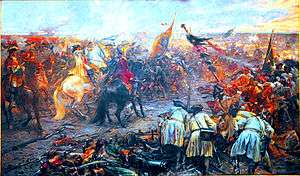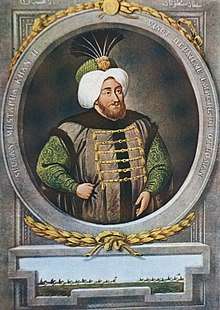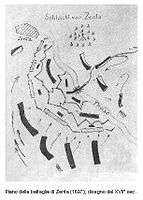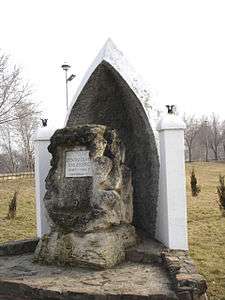Battle of Zenta
The Battle of Zenta (also known as the Battle of Senta), was fought on 11 September 1697, near Zenta, Ottoman empire (today Senta, Serbia), between Ottoman and Holy League armies during the Great Turkish War. The battle was the most decisive engagement of the war, and it saw the Ottomans suffer an overwhelming defeat by an Imperial force one third as large commanded by Prince Eugene of Savoy.
| Battle of Zenta (Battle of Senta) | |||||||
|---|---|---|---|---|---|---|---|
| Part of Great Turkish War Ottoman-Habsburg wars | |||||||
 Franz Eisenhut: The Battle of Zenta | |||||||
| |||||||
| Belligerents | |||||||
|
|
| ||||||
| Commanders and leaders | |||||||
|
|
| ||||||
| Strength | |||||||
|
34,000 infantry[3] 16,000 cavalry[3] 60 guns[4] |
75,000-100,000 men[5][lower-alpha 1] 200 guns[4] | ||||||
| Casualties and losses | |||||||
|
429 killed 1,598 wounded[7] | 30,000 killed, wounded or drowned[5][8][lower-alpha 2] | ||||||
In 1697 a last major Turkish attempt to conquer Hungary was made, Sultan Mustafa II personally led the invasion force. In a surprise attack, Habsburg Imperial forces engaged the Turkish army while it was halfway through crossing the Tisza (Theiß, Tisa) river. The Habsburg forces inflicted thousands of casualties, including the Grand Vizier, dispersed the remainder, captured the Ottoman treasury, and the Seal of the Empire which had never been captured before.
As an immediate consequence, the Ottoman Empire lost control over the Banat, Eugene followed up this great victory by raiding into Bosnia to sack Sarajevo. The scale of the defeat forced the Ottoman Empire into the Treaty of Karlowitz (1699) ceding Croatia, Hungary, Transylvania, and Slovenia to Austria. Zenta was one of the Ottoman Empire's greatest defeats and ultimately signaled the end of Ottoman dominance in Europe.[10]
Prelude
After the Battle of Vienna of 1683, a turning point seemed to have been reached in the Ottoman–Habsburg wars, with Austria and its allies capturing more Ottoman lands. By 1688 Belgrade and most of the Pannonian Plain was occupied by the Habsburgs. But as the war with the French demanded more troops, and the new grand vizier reorganized and reinvigorated the Ottoman Army, the success ended. Belgrade was recaptured by the Ottomans in 1690 and the following year’s campaign was relatively indecisive after the Habsburg army failed in the second siege of Belgrade (1694). Subsequently, the Ottoman army commanded by Sultan Mustafa II won three consecutive victories at the Battle of Lugos (1695), Battle of Ulaş (1696), and Battle of Cenei (1696) while the Venetians lost Chios (1695).[11]
On 18 April 1697, Mustafa went on his third expedition, planning a massive invasion of Hungary, he left Edirne with a force of 100,000 men, the Sultan took personal command, reaching Belgrade late in the Summer, on 11 August, Mustafa gathered a war council the next day. On 18 August the Ottomans left Belgrade heading north towards Szeged.[11]
Battle
Opening manoeuvres

On 5 July 1697, in the newly conquered Pannonian Plain of Hungary, Prince Eugene of Savoy, a young French prince who had distinguished himself greatly in battle, is appointed Commander-in-Chief by Emperor Leopold.[1] His army consisted of 70,000 men with roughly 35,000 ready for battle. As the war chest was empty, Eugene borrowed money in order to pay wages and to create a working medical service. He requested that rations ammunition and equipment be brought up to the level of an army of 50,000.
When news arrived that the Sultan and his army had left Belgrade, Eugene decided to gather all his available troops from Upper Hungary and Transylvania and forced march them towards Petrovaradin, on the Danube, upriver from Belgrade. After the concentration took place, Eugene's forces numbered about fifty thousand to face the Ottomans.
The Habsburg Army consisted of German, Austrian, Hungarian and Serbian infantry and cavalry forces. Palatine Paul Eszterházy of the Habsburg Kingdom of Hungary contributed 12,000 soldiers,[12] the Serbian Militia, 10,000 men, a majority of which cavalry under the orders of Jovan Popovic Tekelija, also joined Eugene's forces.[13] Serbs conscripts also took part in the coalition, notably Vice-Voivode Jovan Monasterlija with his 1000 infantry and 700 cavalry soldiers.[2]
The Ottoman army counted some Hungarian Kuruc cavalries under the leadership of Imre Thököly, however many Kuruc had also joined the Holy League and the call for Crusade.[14] Prince Eugene sent men north to Hegyalja to deal with Hungarian rebels while he concentrated on rebuilding the remainder of the army to face the Turks.[15]
The Sultan and his army crossed the Danube, then made a detour west to capture Titel Castle at the confluence of the Tisza and the Danube, without troops to garrison it, the Ottomans demolished it. In September, they headed north, along the right bank of the Tisza reaching the vicinity of the village of Zenta on the morning of 11 September. Prince Eugene followed marching the Imperial army south from Petrovaradin.[15]
The battle
On 11 September 1697, the Ottoman army began to ford the river Tisza near Zenta, unaware that the Imperial Army was nearby. Captain Jovan Popović Tekelija, commander of the Serbian Militia, who was monitoring the advances of the Ottomans, immediately informed Prince Eugene. Tekelija then led the Imperial army over swamps and bog to the rear of the Turks encampment.[2] Two hours before sunset, the arrival of the Habsburg army’s Imperial army shocked the Ottoman forces as they were still in the process of crossing the river and did not think that the imperial army could get here so quickly.[6] Sultan Mustafa, his baggage, and the artillery were on the Temeşvar bank while most of the infantry was still with the Grand Vizier on the other bank.
.png)

As the light was starting to fail the entire Habsburg force, with cavalry on each side and the infantry in the middle, launched an all-out assault from the rear, attacking in a crescent shape movement against the defensive position of the Ottomans.[15] The left flank of the Imperial army commanded by General Guido Starhemberg penetrated between the Ottoman left and the bridge, trapping them against the river. The army's right wing was under the command of General Sigbert Heister. At the same time, Imperial forces lead by Charles-Thomas de Vaudémont, attacked from the front and, after engaging in close-quarter fighting, broke through the trenches surrounding the Ottoman camp.[16] The command of the Turkish cavalry was under Hungarian Imre Thököly, who also supported the sultan with some additional Kuruc cavalry.
The Imperial Dragoon of General Starhemberg dismounted and proceeded to the moat encircling and engaging the Ottoman camp and soon broke through the Turkish line of defense. Ottoman troops behind the entrenchments retreated in confusion to the bridge, which was now overcrowded, heavily bombarded, and soon collapsed.
Thrown into disorder, the trapped Ottoman troops fell into chaos with thousands falling into the river, Austrian artillery devastated the surviving Ottomans as they tried to escape. The Sultan watched helplessly from the other side,[lower-alpha 3] before he decided, after ordering the remaining troops to secure the bridge, to abandon his army and retreat. Escorted by a cavalry detachment and accompanied by his tutor and mentor Sheikh-ul-Islam Feyzullah Efendi, Mustafa set off for Temeşvar, without stopping along the way, only taking what horses could carry.[6] When the Habsburg army reached the far bank they found that the sultan had left behind him 87 cannons, 9000 baggage carts, 6000 camels and 15,000 oxen.[15] In addition, the Austrians found the Ottoman royal treasure chest, containing three million piastres and the state seal of Grand Sultan Mustafa II of the Ottoman Empire which had never been captured by an enemy before,[10] the seal was inscribed with the words "Mustafa, son of Mehmed Han, always victorious" and the year of his accession to the throne "1106 of the Hejra " (1695 according to the Christian calendar).[lower-alpha 4] After the victory, Prince Eugene personally presented the emperor with the pieces that were captured at the Battle of Zenta.
In total 30,000 Turks died including the grand vizier, killed on the battlefield by mutinous Janissaries, and many of the most senior figures in the Ottoman military-administrative establishment,[6] while the Holy League suffered 429 casualties.[11][17] The great difference in casualties was partly due to the tactical superiority of the imperial army and cannon technology which, unlike the Ottomans, the Austrians had improved to a great extent.[18]
Aftermath
The battle resulted in a spectacular victory for Austria; The main Ottoman army was scattered and the Austrians gained complete freedom of action in Bosnia, Sarajevo is captured and sacked on 22 October after Eugene mounted a raid with six thousand cavalry including Serbian Militia of the Sava, plundering and burning the city to the ground.[12]
After fourteen years of war, the battle at Senta proved to be the catalyst for peace, in early 1699 mediators of both sides started peace negotiations in Sremski Karlovci under the supervision of English ambassador to Constantinople, William Paget. By the terms of the Treaty of Karlowitz, signed near Belgrade on 26 January 1699, Austria gained control of Hungary (except for the Banat of Temesvar and a small area of Eastern Slavonia), Transylvania, Croatia and Slavonia; The returned territories were partly reintegrated into the Kingdom of Hungary, and partly organized as separate entities within the Habsburg Monarchy such as the Principality of Transylvania, and the Military Frontier. The Turks kept Belgrade and Serbia. The victory ultimately signaled the end of Ottoman dominance in Europe.[10]
Images
 painting of the battle from around 1698
painting of the battle from around 1698
 Depiction of the Battle of Senta 1697 by Jan van Huchtenburgh c.1725
Depiction of the Battle of Senta 1697 by Jan van Huchtenburgh c.1725
Notes
- as reported by Caroline Finkel, Ottoman historian, Mehmed Ağa distrusted the Grand Vizier and accused him of exaggerating the size of the army in order to mislead the Sultan, Ağa claimed that in the two previous years, the numbers had been closer to 50,000.[6]
- according to Erhan Afyoncu, rector of the military university in Istanbul, 7,000-8,000 Ottomans died[9]
- as documented by Ottoman historian, Mehmed Ağa who was with the Sultan’s party, at Mustafa’s instruction, and chronicled the events in details.[6]
- The Sultan's seal is visible today in the Museum of Military History in Vienna
References
Citations
- Kann 1974, p. 67.
- Samardžić & Duškov 1993, p. 50.
- Parker, p. 538.
- Chandler 1990, p. 150.
- Faroqhi, p. 97.
- Finkel 2012, p. 906-908.
- Austro-Hungarian Monarchy. Kriegsarchiv 1878, p. 156.
- Clodfelter 2008, p. 59.
- TDV İslâm Ansiklopedisi.
- Robinson 2018, p. 123.
- Sandler 2002, p. 985.
- Nouzille 2020, pp. 627–639.
- Popović 1990, p. 170.
- Szántai & Wollaston 2017, p. 26.
- Wheatcroft 2009, p. 230-231.
- Grant 2017, p. 388.
- Tucker 2010, p. 676.
- Çiçek et al. 2000, p. 21.
Bibliography
- Austro-Hungarian Monarchy. War Archives (1878). The campaigns of Prince Eugene of Savoy: According to field reports, ed. from the department for war history of the k. k. War Archives (in German). Verlag des k. k. Generalstabes.
- Chandler, D.G. (1990). The Art of Warfare in the Age of Marlborough. [The Commanders]. Spellmount. ISBN 978-0-946771-42-4.CS1 maint: extra punctuation (link)
- Çiçek, K.; Kuran, E.; Göyünç, N.; İnalcık, H.; Ortaylı, İ.; Eren, G. (2000). The Great Ottoman-Turkish Civilisation: Philosophy, science, and institutions. The Great Ottoman-Turkish Civilisation. Yeni Türkiye.
- Clodfelter, M. (2008). Warfare and Armed Conflicts: A Statistical Encyclopedia of Casualty and Other Figures, 1494-2007. McFarland. ISBN 978-0-7864-3319-3.
- Faroqhi, S. The Cambridge History of Turkey: The Later Ottoman Empire, 1603–1839. Cambridge history of Turkey. Cambridge University Press.
- Finkel, Caroline (2005). Osman's Dream: The Story of the Ottoman Empire, 1300-1923. New York: Basic Books. ISBN 978-0-465-02396-7.
- Grant, R.G. (2017). 1001 Battles That Changed the Course of History. Book Sales. ISBN 978-0-7858-3553-0.
- Kann, R.A. (1974). A History of the Habsburg Empire, 1526-1918. University of California Press. ISBN 978-0-520-02408-3.
- Liptai, E. (1984). Military history of Hungary: in two volumes (in Hungarian). Zrinyi Katonai kiadó.
- Markó, L. (2006). The dignitaries of the Hungarian state: From St. Stephen to the present day (in Hungarian). Helikon. ISBN 978-963-208-970-6.
- Pach, Z.P. (1985). History of Hungary: 1526-1686. Magyarország története (in Hungarian). Akadémiai Kiadó. ISBN 978-963-05-4098-8.
- Parker, R.C.G. Readers Comp to Military History Pa. Houghton Mifflin Harcourt. ISBN 978-0-547-56146-2.
- Peters, R. (2011). Endless War: Middle-Eastern Islam Vs. Western Civilization. Stackpole Books. ISBN 978-0-8117-0823-4.
- Popović, D.J. (1990). Serbs in Vojvodina: From the Peace of Karlovac in 1699 to the Council of Timisoara in 1790. Srbi u Vojvodini (in Serbian). Matica srpska. Retrieved 2020-08-16.
- Robinson, T. (2018). Battles that Changed History: Epic Conflicts Explored and Explained. Dorling Kindersley Limited. ISBN 978-0-241-37359-0.
- Samardžić, R.; Duškov, M. (1993). The Serbs in European Civilization. Balkanološki Institut Beograd: Posebna izdanja. Nova. ISBN 978-86-7583-015-3.
- Sandler, S. (2002). Ground Warfare: An International Encyclopedia. Ground Warfare: An International Encyclopedia. ABC-CLIO. ISBN 978-1-57607-344-5.
- Szántai, G.; Wollaston, L. (2017). 33 Castles, Battles, Legends: Hungarian-Ottoman War Series 1. Hungarian-Ottoman War Series. Independently Published. ISBN 978-1-9733-7892-1.
- Tucker, S. (2010). A Global Chronology of Conflict: From the Ancient World to the Modern Middle East. A Global Chronology of Conflict: From the Ancient World to the Modern Middle East. ABC-CLIO. ISBN 978-1-85109-667-1.
- Wheatcroft, A. (2009). The Enemy at the Gate: Habsburgs, Ottomans and the Battle for Europe. Random House. ISBN 978-1-4090-8682-6.
Journals
- Nouzille, Jean (2020-08-16). "La campagne décisive du prince Eugène en Hongrie (1697)". Dix-septieme siecle (in French). n° 229 (4): 627–639. ISSN 0012-4273.
Website
- "Zvonik". zvonik.rs (in Croatian).
- "ZENTA". TDV İslâm Ansiklopedisi (in Turkish).
- "The perils of insouciance". Osman's Dream: The History of the Ottoman Empire.
- Kft., Antikvarium.hu. "Csorba Csaba: Magyarország képes története (Magyar Könyvklub, 2003)". Antikvarium.hu (in Hungarian).
| Wikimedia Commons has media related to Battle of Zenta. |